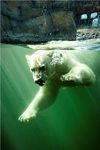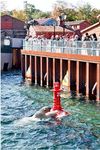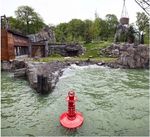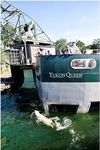Polar Bear Exhibit at Yukon Bay Theme World | Hannover Adventure Zoo
←
→
Page content transcription
If your browser does not render page correctly, please read the page content below
Polar Bear Exhibit at Yukon Bay Theme World | Hannover Adventure Zoo The polar bear exhibit is part of the Yukon Bay theme world and encompasses a 26,500 square metre area. Opened to the public in May 2010, Yukon Bay is the seventh theme world at Hannover Adventure Zoo. At Yukon Bay, wolves, caribou, bison and prairie dogs are presented in the rugged wilderness of Canada. An enormous harbour basin with saltwater and a wave generator is home to polar bears, fur seals, sea lions and grey seals that visitors can view eye to eye. All enclosures are viewable from a variety of angles. Water is the defining element of the entire Yukon Bay exhibit. The water surface area of the penguin, seal and polar bear exhibit is 60% larger than its predecessor. Nevertheless, water usage for the compound has decreased 80%. Using sustainable technologies, 3,100 cubic metres of saltwater can be completely circulated within one to two hours. Speed-controlled pumps, large particle filters, protein skimmers, ozone disinfection, additional gravel bed filters with a UV system, backwash water reclamation and saltwater replenishment with PH value control provide water quality suitable for fish stocks and underwater visibility of approximately fifteen metres. 1/6
The polar bear exhibit is situated next to a small, old Canadian harbour settlement. Visitors can see out over the northern section of the exhibit from the harbour wall. All barriers between man and animals are designed to look like authentic components of the harbour and landscape. Swells and saltwater breezes reinforce the realism of the experience. The polar bear enclosure is defined primarily by the ample allotment of natural ground areas and a 900 square metre saltwater basin featuring a wave generator. Water depth ranges from shallow water coves to depths of up to 3.5 metres. The seawater is home to sea trout, where there is ample room for retreating and eluding danger. This benefits the behavioural enrichment of the animals. Rocky crags and a floating buoy provide opportunities for play. Located on land are various feeding hatches that open automatically at different times of day. Sand baths, areas with pine mulch and gravel zones are used for burrowing and grooming. 2/6
The two, separable polar bear enclosures consist primarily of natural ground area planted with vegetation and featuring natural and artificial rock formations, sand, gravel and pine mulch areas as well as a 900 square metre saltwater basin with a wave generator and stocked with fish. The outdoor polar bear exhibit consists of two sections that can be linked together when needed. The animals have access to 1,500 square metres of total land surface area and 900 square metres of saltwater surface area. The stall building, caretaker area and technical zone encompass 450 square metres. The one-story building is tucked away under the hilly outdoor exhibit and its front side is integrated into the landscape. A façade of windows is located on the backside, allowing daylight into the space. Various features of the polar bear exhibit provide for the behavioural enrichment of the animals. This includes the feeding boxes, which are hidden in the artificial rocks and electronically operated by caretakers from inside the stall. A frozen block of consumable treats for the animals can be attached to the floating buoy, which can be pulled in along a track via a crank-operated cable winch. 3/6
The plantings are based on the polar bear’s natural habitat, the Yukon Territories in Canada. Plant species incompatible with local conditions or not grown in Germany were replaced with visually similar ones. Dominating the exhibit is a balanced relationship between visually dense, coniferous evergreens and North American deciduous trees with characteristic autumn coloration. Existing trees were largely retained. Where the project necessitated the removal of certain trees, these were replaced by recognized species like birch, poplar and maple since these are also native to North America. Robust plant species were selected for the animal areas that do not react adversely to browsing, damage or frequent urination. A special feature is the (wild) shrub plantings, which provide colour accents in the enclosures and visitor areas, thereby creating a better visual impact. For areas exposed to salt water, the appropriate grasses and shrubs were selected such as sea buckthorn. The landscape around the harbour basin flows seamlessly into the Eilenriede city park located nearby. The trench situated between the forest and the enclosure is not visible to visitors. The polar bear stall is located underneath the outdoor compound that rises toward the back and is therefore not recognizable as a building. Visitors can look out over the southern part of the enclosure from the deck of the ship that has run aground. From the belly of a capsized freighter, visitors can observe the polar bears eye to eye. 4/6
The polar bear enclosure is only accessible through gates and safety locking mechanisms. When needed, a wheeled loader can be driven through three-metre wide access gates. Caretakers can guide each animal individually from its holding stall directly to the southern or northern part of the enclosure. A caretaker passageway runs parallel to the animal passageway. Sliding gates hidden from direct view are monitored via cameras. The separation of the enclosure into two parts is required both for breeding as well as for altering the polar bear groupings within the separate enclosures. Located inside the stall building is a separate mother- offspring zone, designed as a cave, which allows staff and visitors a view inside in the event of a newborn cub. For medical examinations and treatment, a special cage is available for constraining the animal without having to place it under general anaesthetic. When needed, a wheeled loader can access the outdoor area through three metre-wide, double-door access gates. In addition, both enclosure sections can be linked via a retractable bridge that extends over the dry trench. And, when the sections are linked, the animals can dive underwater through a sliding gate built inside the harbour crane. The crane boom allows caretakers to feed the animals from impressive heights for narrated shows. 5/6
The basic visitor education concept for all the animal enclosures at Yukon Bay is centered around three components: an unexpected proximity to the animals, the dynamic signage and the educational feeding demonstrations. The polar bear enclosures feature elaborate, hand painted signage and panels that appeal especially to children and dynamically illustrate the life of polar bears. While the polar bears are being fed from the lofty heights of the harbour crane, the caretakers offer worthwhile facts about the life of polar animals over the loudspeakers as well as information on threats to and preservation of their natural habitats. dan pearlman Experience Architecture GmbH Bettina Krause Kiefholzstraße 2 12435 Berlin May 2013 6/6
You can also read



























































